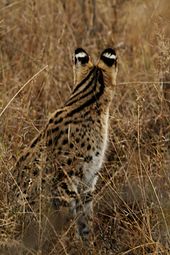Eye-spot (mimicry)
An eye-spot (or ocellus) is an eye-like marking on the body of an animal. They are found on butterflies, reptiles, felids, birds and fish.


Eye-spots may be a form of mimicry: the spot looks like the eye of a larger animal. Its function may be to draw a predator's attention away from the most vulnerable body parts; or to look like an unpleasant or dangerous animal.[1][2][3]
In larger animals, eyespots may play a role in intraspecies communication or courtship – the best-known example is probably the eyespots on a peacock's display feathers.
There is evidence that eyespots in butterflies are anti-predator defences. Some are deimatic displays to distract, startle or scare off predators, or at least to deflect attacks away from vital body parts.[4] Butterfly eyespots may also play a role in mate recognition and sexual selection,[5][6] like the eyespots on larger organisms.
References
change- ↑ Stevens, Martin (2005). "The role of eyespots as anti-predator mechanisms, principally demonstrated in the Lepidoptera". Biological Reviews. 80 (4): 573–588. doi:10.1017/S1464793105006810. PMID 16221330. S2CID 24868603.
- ↑ Stevens, Martin & Ruxton, Graeme D. 2014. Do animal eyespots really mimic eyes? Current Zoology 60, 1, p26. [1]
- ↑ Blest A.D. 1957. The function of eyespot patterns in the Lepidoptera. Behavour 11, 209–255.
- ↑ Vallin A.; et al. (2005). "Prey survival by predator intimidation: an experimental study of peacock butterfly defence against blue tits". Proceedings Royal Society: Biological Sciences. 272 (1569): 1203–1207. doi:10.1098/rspb.2004.3034. PMC 1564111. PMID 16024383.
- ↑ Costanzo K. & Monteiro A. (2006). "The use of chemical and visual cues in female choice in the butterfly Bicyclus anynana". Proceedings Royal Society: Biological Sciences. 274 (1611): 845–851. doi:10.1098/rspb.2006.3729. PMC 2093980. PMID 17251116.
- ↑ "Female butterflies chase males when it's cool". Sify. Archived from the original on 2022-05-18. Retrieved 2019-02-15.